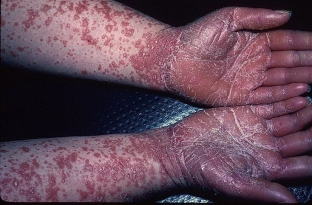In their practice, dermatologists almost daily face a number of common skin diseases. Quite often, the patient turns to a specialist, having a characteristic set of symptoms, which greatly facilitates the diagnostic process. However, sometimes doctors have to deal with rare diseases that are much more difficult to diagnose and treat. One of these diseases is Devergie's disease – a rare skin pathology that is a serious problem for the patient. Read more about this disease on estet-portal.com in today's article.
Devergie's disease: clinical picture and treatment methods
Devergie's disease or red pityriasis pilaris lichen – it is a rare dermatological pathology, accounting for only 0.03% of the total number of skin diseases.
Devergie's disease is a heterogeneous chronic inflammatory process that is divided into hereditary and acquired forms.
It is generally accepted that the name and description of this disease belongs to Alphonse Devergy, although the first case of the pathology was reported in 1828 by Claudius Tarral, who described isolated scaly rashes with a dense, rough surface, penetrated in the center by a hair.
Devergie's Disease:
- etiology of Devergie disease: possible causes;
- Devergie's disease clinical picture: symptoms of the disease;
- effective treatments for Devergie's disease.
Etiology of Devergie disease: possible causes
At the moment, the etiology of Devergy's disease is not fully understood, and scientists differ in their views on the causes of the disease. The main theory of the occurrence of pathology is genetic, implying a hereditary predisposition to a disease transmitted in an autosomal dominant way. In addition, as a result of the study of papules infiltrate, scientists found that in pathology there are changes in keratin characteristic of such dermatoses as ichthyosis or psoriasis. Another theory of the occurrence of the disease is associated with the immunity of patients. As it turned out, in Devergie's disease, the level of T-helpers decreases and the number of T-suppressors increases, which can also be the cause of the disease.
Clinical picture of the disease Devergi: symptoms of the disease
The clinical picture of Devergie's disease is characterized by the presence of the following symptoms:
- formation of spiky papules on the skin with keratin plugs;
- presence of islands of healthy epidermis interspersed with rashes;
- changes in skin color in the lesion to red or carrot color;
- formation of scales of peeling of various diameters;
- deformation and discoloration of nails;
- hyperkeratinization of the skin of the feet and hands;
- formation of Besnier cones – keratin plugs in the papules of the fingers;
- presence of cracks in the skin;
- pain, itching, peeling and tightness of the skin.

Effective treatments for Devergie disease
Retinoids are currently the main drugs for the treatment of Devergie's disease. It is these funds that contribute to the restoration of the structure of the skin. Treatment is long-term: improvement is observed a month after the start of therapy, and the resolution of the pathology occurs, on average, after 9 months. Sometimes treatment can stretch for several years, which is important to warn the patient in advance. In order to minimize the side effects of retinoid use, such as dry skin and mucous membranes, vitamin A creams are prescribed, as well as essential oil baths.
The treatment regimen for Devergie's disease is developed by the doctor, based on the individual characteristics of the body of each patient.
Estet-portal.com thanks you for your attention. Read more interesting articles about skin diseases on the website in the "Dermatology" section.







Add a comment